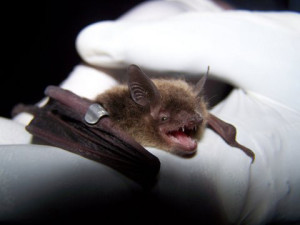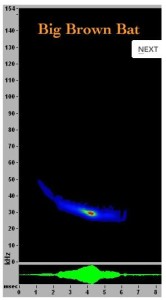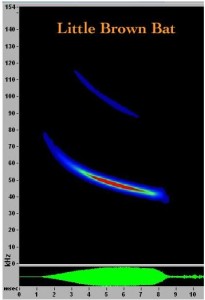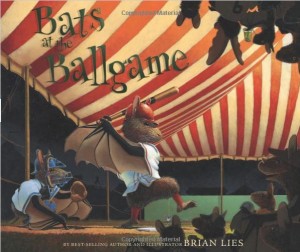Brown Bats For Beginners

Brown Bats 101
You can't look at Halloween decorations without seeing bats hanging everywhere. They are often lumped with spiders and black cats and relegated to the "scary things" category. Like many "scary" things, bats really aren't that bad if you understand a little bit about them. This is why I want to introduce you to brown bats, a good place to start on your way to appreciating our bat neighbors. After all, Bat Week is October 25th-October 31st (Have you planned your party yet??)!

BATS AREN'T RODENTS
First, let's get this straight, bats are not rodents. If you question this simply throw a mouse in the air and see if it flies. Bats are the only flying mammals. The creature that comes closest are flying squirrels and they simply leap like demented nocturnal paragliders and then float around using the flaps of skin between their arms and legs as they go from tree to tree.
The two of the most common bats in North America are the little brown bat (Myotis lucifugus) and the big brown bat (Eptesicus fuscus). The little brown bat belongs to the genus Myotis, meaning "mouse-eared bat," which may be why there is some confusion about bats being rodents. Little brown bats do have cute little mouse ears, but they are NOT mice. Another reason for confusion is the German word for bat, "fledermaus" (pronounced fley-der-mous) which translates into "flutter-mouse."
Big brown bats are in a different genus from the little brown bats, called Eptesicus, which is considered the "house-bat" family. These are often found in attics and old barns.
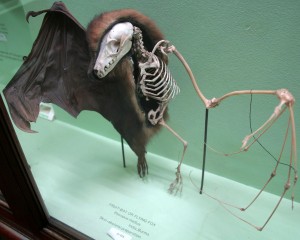
All bats are in the order Chiroptera, which means hand-wing. Imagine bending your wrist, and elongating your fingers to a little over the length of your body and stretching soft pliable skin between the fingers, this is about what bats have to help them fly.
AREN'T ALL BROWN BATS "LITTLE" AND "BIG" BROWN BATS?
Nope, not all bats are brown bats. There are many, many, many different types of bats, and some happen to be brown, but they are not all "big" and "little" brown bats. Scientists just got kind of lazy and called these two common species little and big brown bats, despite the fact that they are not even in the same genus. That being said, it's sometimes quite hard to tell them apart. Researchers even go so far as to compare the length of hairs on their toes!!! Yes, I have done this, and no it's not easy (putting it on a resume is kind of awesome though). So, since they're hard to tell apart, here's a quick chart to help you learn the difference:
COMPARE "LITTLE" (8-11" WING SPAN) TO "BIG" (11-13" WING SPAN)
| Little Brown Bat | Big Brown Bat | |
| Name | Myotis lucifugus | Eptesicus fuscus |
| Genus | Myotis | Eptesicus |
| Color | Uniform dark brown fur with a lighter belly, glossy on back and grayish underneath | Somewhat long dark brown fur, that looks long and silky, chocolaty brown in color, not light brown |
| Body Size | 2-4" (females are larger) | 4-5" (females larger) |
| Wingspan | 8-10" | 11-15" |
| Weight | .18-.49 oz | .5-1.2 oz |
| Diet | Insects (Insectivore) | Insectivore |
| Navigation | Echolocation (sonar) | Echolocation |
| Life span | 6-7 years | 18-20 years |
| Colonial? | Lives in colonies | Lives in Colonies (20-300/colony) |
| Range | Entire N. America and Southern Canada | Eastern US |
| Habitat | Forests, caves, open fields most often near water | Forests, caves, fields |
| Mating Season | August, birth is September | November through March, birth in June |
| Number of offspring | Usually one | Usually one (can have twins) |
| Hibernation | Hibernates in buildings, caves, rocks, trees, and wood. | Hibernates in trees, caves, rocks, houses, barns, and buildings |
| Notes | Extremely hardy, can withstand larger temperature fluctuation than many bats, which is why they are so ubiquitous | One of the fastest bats, can reach up to 40 mph |
Size, fur color, and poop are all good ways to tell the two bats apart. Here are some images for comparison. Below are two images of a little brown bat. Notice the buffy underside of the little brown bat. It has light brown fur on top, which is short and stands up. It also has a short stubby nose along with mouse-like ears.

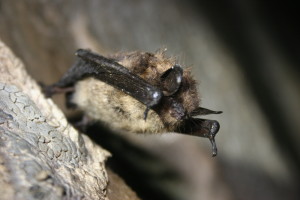
Next are images of a big brown bat. Notice the larger size, longer hair that looks almost like chocolate (mmm...bat fur), and the longer snout. Not all big browns have deep chocolate fur, sometimes they can run to a buffy brown, but the fur is always longer than the little brown, and can look somewhat wavy (see bottom picture).
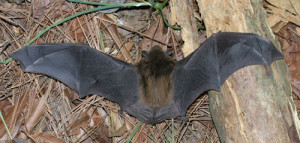
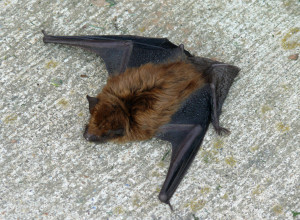
Below is a face shot of each type of brown bat. Notice the more seal-point face of the big brown bat, along with longer fur and more consistent chocolate coloring. On the little brown the face is less dark and the back fur is more buff colored.

And that brings me to poop. What would one of my blog posts be without poop? Poop is also a good way to tell the two apart, especially if all you can see are their tiny bodies wedged way high in an attic ceiling. This graphic from the Vermont Department of Fish and Wildlife is very helpful.
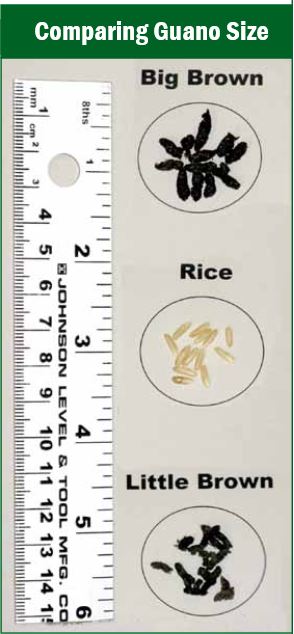
You can see from the photos that that the big brown bat guano is slightly larger than a grain of white rice, while little brown bat guano is about the same size if not slightly smaller, should you care to get close enough to measure!
Another clue about which bat you have is location. Big brown bats are found throughout the entire Eastern US, but not in the West. Little brown bats are found across all of North America and lower Canada. This is because they are better at handling extreme temperature variations.
BROWN BAT CALLS
I'm not going to go into detail about bat calls, but you probably know that all bats use echolocation to navigate, which is just sound bouncing around and coming back to them (just like dolphins). Big brown bats have sonic calls that are in a lower frequency range than little brown bats. This is one way that researches can tell the the difference between the two without capturing them. Check out the great sonogram images from the "Bats About Our Town" website.
Here you can see the difference in frequency, duration and intensity of the two bat's calls (Photo: Bats About Our Town).
I used to do research on bat echolocation, and it's a fascinating field. There are even bat dialects between northern and southern brown bats (I kid you not), like "chirp..chirp..chirp eh?" versus ""chirp...chirp..chir...yall." There is even differentiation within similar species depending on where they are collecting food (here's the research). Check out my previous post to learn more about identifying bats through echolocation patterns.
TOE HAIRS
Here's the part where bat scientists seem to cross over into the (very) strange....looking at bat toe hairs. Sometimes it can be just down-right difficult to differentiate a "big" little brown bat from a "little" big brown bat (say that ten times fast) in the dark. This is why they often look at toe hairs. You will probably never have cause to use this useless trivia, but it's interesting, and could be a great of a conversation starter. Little brown bats have very long and dense toe hairs that extend from the tip of their cute little ankles to the ends of their toes. Big brown bats have sparse toe hairs that extend past their toes. They also have a keeled calcar. A calcar is sort of like big toe. Big brown bats have a bump coming off theirs and little brown bats don't (see image below).
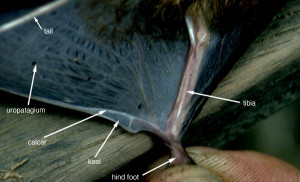
BROWN BATS (AND ALL BATS) ARE OUR BUDDIES
Regardless of whether or not you like bats, they are critical to the survival of rain forests and deserts, because they disperse seeds and pollinate cactus flowers. Without them we wouldn't have tequila (they pollinate agave plants), and we would be overwhelmed by insects. Brown bats, like the little brown and big brown bats are excellent insect eaters and they help farmers and home owners with beetles, flies, mosquitoes, and other pests. It's estimated that bats eat tons of insects every summer night. One of their favorite foods of insectivorous bats is corn earworm moths (they attack corn, artichokes, and watermelons as well as tomatoes). It is estimated that these pests cost farmers over one billion dollars every year, but bats help mitigate this cost by eating the adult moths. Scientists estimate that, "They are worth more than $3.7 billion a year in reduced crop damage and pesticide use" (Bat Conservation International).
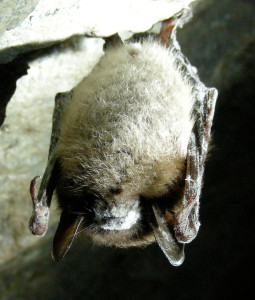
Currently many species of bats in North America are suffering from white nose syndrome (WNS), which is a very deadly disease that kills entire colonies of bats. Little brown bats are especially at risk and are disappearing in large numbers. " Scientists estimated that between 2016 and 2018 little brown bat populations that once contained millions of bats could decrease to lower than 100,000 animals. Also, some populations may not begin to increase again until around 2023" (Whitenosesyndrome.org). To learn more you can read the update from the USGS Newsroom.
BAT RESOURCES
There are many organizations working to save bats, support endangered bats, and bring about bat conservation. My favorite is Bat Conservation International (BCI). Check out their web page for fun "Bat Week" information, crafts, bat house plans, and facts. I love their free BATS Magazine. Here's a link to their Fall 2015 Issue.
My all time favorite children's book is "Stella Luna" by Janell Cannon. Next this are the "Bats" books by Brian Lies. The books are wonderfully illustrated and the puns and writing are so well crafted that you'll want to read them again and again. My favorite is "Bats at the Ballgame" and "Bats at the Library." For older readers, the "Silverwing" Trilogy by Kenneth Oppel is fantastic romp into the world of bat fantasy/fiction even for adults. It's a true page turner and has five stars. Consider checking out these classics at the library for Bat Week and Halloween.


